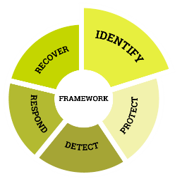Identify Assets
Within the Identify core function of the Cybersecurity Framework of CCB Belgium, a number measures and processes are established and managed. All with the purpose of identifying assets like systems, data, people, buildings, software, data till buildings and other assets defined.
On this page you will learn what is being expected from the NIS2 law and what kind of solutions Kappa Data can offer you.
Identify definition from Cyberfundamentals Framework
Guidelines and Obiligations from CCB Belgium
In the Cyberfudamentals framework of CCB Belgium a list of measures are described where you can find the headlines below :
- Physical devices and systems used within the organization are inventoried
- Software platforms and applications used within the organization are inventoried
- Organizational communication and data flows are mapped
- External information systems are cataloged
- Resources are prioritized based on their classification, criticality and business value
- Cybersecurity roles, responsibilities, and authorities for the entire workforce and third-party stakeholders (like suppliers, customers, partners) are established.
- The organization’s role in the supply chain is identified and communicated.
- The organization’s place in critical infrastructure and its industry sector is identified and communicated
- Priorities for organizational mission, objectives and activities are established and communicated.
- Dependencies and critical functions for delivery of critical services are established
- Resilience requirements to support delivery of critical services are established for all operating states (like under duress/attack, during recovery, normal operations)
- Organizational cybersecurity policy is established and communicated
- Legal and regulatory requirements regarding cybersecurity, including privacy and civil liberties obligations, are understood and managed.
- Governance and risk management processes address cybersecurity risks.
- Asset vulnerabilities are identified and documented.
- Cyber threat intelligence is received from information sharing forums and sources.
- Threats, vulnerabilities, likelihoods and impacts are used to determine risk.
- Risk responses are identified and prioritized.
- Risk management processes are established, managed and agreed by organizational stakeholders
- Organizational risk tolerance is determined and clearly expressed.
- The organization’s determination of risk tolerance is informed by its role in critical infrastructure and sector specific risk analysis.
- Cyber supply chain risk management processes are identified, established, assessed, managed and agreed to by organizational stakeholders
- Suppliers and third-party partners of information, components, and services are identified, prioritized and assessed using a cyber supply chain risk assessment process.
- Contracts with suppliers and third-party partners are used to implement appropriate measures designed to meet the objectives of an organization’s cybersecurity program and the Cyber supply chain risk management plan.
- Suppliers and third-party are routinely assessed using audits, test results, or other forms of evaluations to confirm they are meeting their contractual obligations.
- Response and recovery planning and testing are conducted with suppliers and third-party providers
Identification Assets
You can’t protect what you don’t see
Everything starts with identification of your assets. Assets are within the NIS2 directives defined as IT systems, Software applications, Data, People, Procedures, Building(s), Cars, knowledge, etc. All of these assets needs to be inventoried and risk analysis needs to be performed for each asset.
For example : you have one person that knows every detail of the production mix of a product, but this person becomes sick for a longer time. When you did’t documented his/her knowledge, then you might have a severe risk. For IT-systems it is evident that these systems are equipped with the latest security solutions, in order to protect your systems against the most modern cyber attacks.
Kappa Data has different solutions to offer that fills in several parts within this identenfication and risk analysis process.
Let’s look at the different solutions :
Asset Identification and Risk Analysis
In alignment with the Identify Core function of the NIS2 directives in Belgium, the organization needs to be committed to a comprehensive approach to asset identification and risk analysis. This strategy ensures that all IT, IoT, and OT devices within our network are accounted for, secured, and managed effectively.
To achieve this, Kappa Data is leveraging several advanced solutions:
1. Identifying Assets via runZero:
Armis is a robust platform used for identifying all connected devices within our network. It plays a critical role in vulnerability management, enabling us to continuously monitor and secure IT, IoT, and OT devices. With Armis, we gain full visibility into our device landscape, helping us identify and mitigate risks promptly.
2. Network Access Control (NAC) by Extreme:
The NAC solution from Extreme Networks is essential for determining and controlling who can access various segments of our network. This solution enforces security policies, ensuring that only authorized users and devices can connect to our network resources. By doing so, it significantly reduces the risk of unauthorized access and potential security breaches.
3. Authenication with JumpCloud:
JumpCloud is our chosen platform for the authentication process of users accessing our network. This solution simplifies and secures user authentication, providing single sign-on (SSO) capabilities and multi-factor authentication (MFA). It ensures that only verified users can access critical systems and data, thus enhancing our overall security posture.
3.1 Single Sign-on
With single sign-on users only have to enter one set of credentials to access their web apps in the cloud and behind the firewall – via desktops, smartphones and tablets. This foundational identity and access management (IAM) measure is a first step in building trusted experiences for your workforce, customers, and partners.
3.2 Multi-factor authentication
Multi-factor Auhtentication or MFA is an important part for secure access to your business applications or your network, especially in the current cyberspace environment. Within the NIS2 directives, MFA is highly recommended. On this page we will explain the role of MFA for your users and how you can improve MFA by the use of Smart-Factor Authentication.
3.3 Identity Lifecycle Management
OneLogin Identity Lifecycle Management emphasizes efficient onboarding by importing entitlement definitions from every application and offering flexible rules for user entitlements. Role, department, location, and title are the basis for access control.
3.4 JumpCloud Remote Access
Establish secure, direct connections to troubleshoot devices from anywhere in the world to solve active technical issues with JumpCloud Remote Access.
3.5 Priviledged Access Management (PAM
Grant and record granular access control to everything. From SaaS applications, to cloud infrastructure, to databases, and more with JumpCloud Priviledged Access Management solution.
3.6 JumpCloud Password Management
Create, store, and protect user credentials locally on devices, and centrally manage passwords using JumpCloud’s unique decentralized architecture.
3.7 JumpCloud Device Management
Manage all your operating systems, including macOS, Windows, Linux, iOS, iPadOS and Android with JumpCloud Device Management.
3.7 JumpCloud Patch Management
Simplified, scheduled, and automated patch management and version control for Windows, macOS, Ubuntu Linux, browsers, and applications with JumpCloud Patch Management.
3.8 JumpCloud Shadow IT
Discover, secure, manage, and optimize every SaaS app and user across your organization. Block or redirect the use of authorized applications with JumpCloud SaaS Management.
4. Vulnerability management of Assets
With runZero, it is possible to have a general overview of your Asset Inventory and which assets show vulnerabilities. runZero will scan your IT, IoT and OT network in a safe, agentless and without credentials via the cloud console or on premise. Discover all your assets in an unauthenticated way, the way a hacker would.

